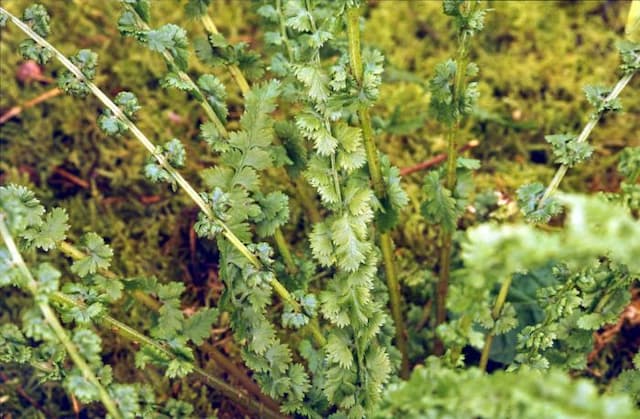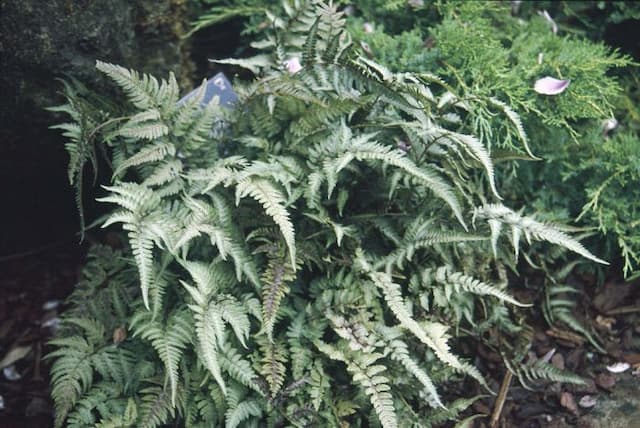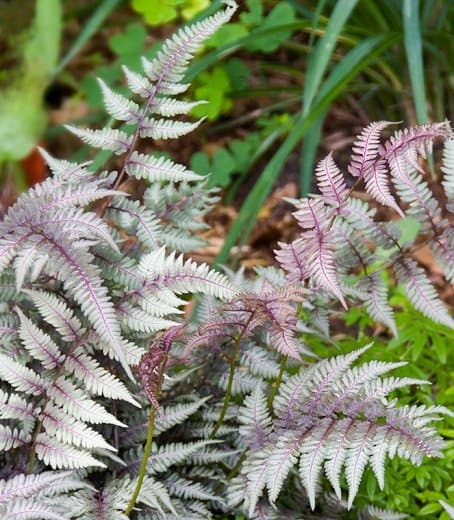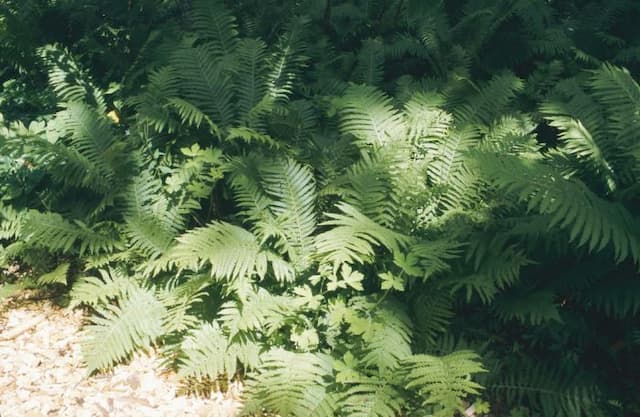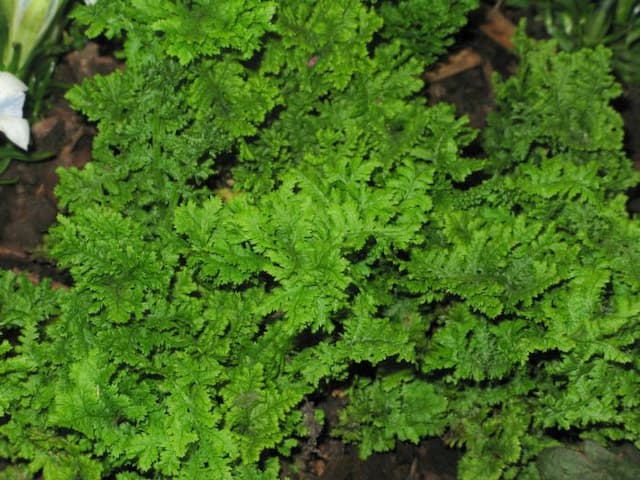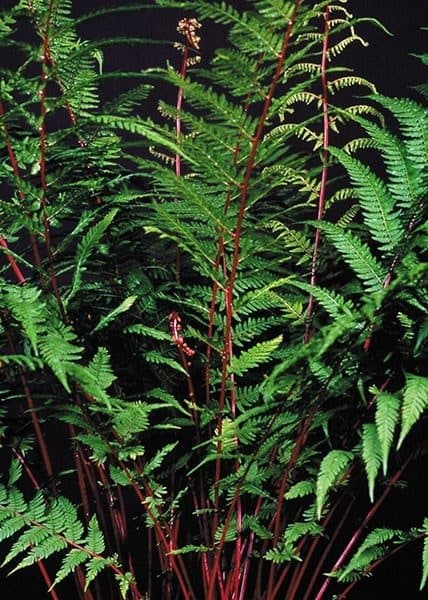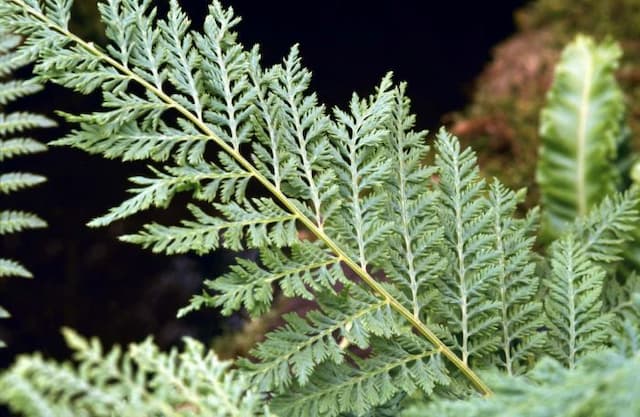Moupin Fern Cystopteris moupinensis
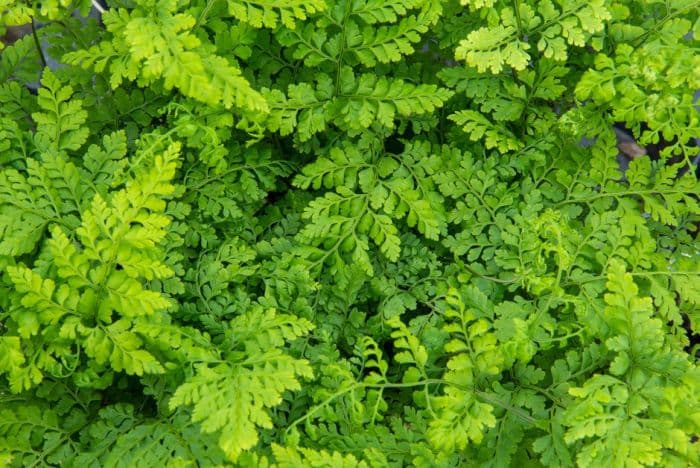
ABOUT
Cystopteris moupinensis, more commonly known as the Moupin fern, is a species that typically thrives in shaded or wooded areas. It is characterized by its delicate and feathery fronds that emerge gracefully, forming a textured and layered appearance. The fronds are usually composed of numerous smaller leaflets that are organized in a pinnate fashion, meaning they are arranged on either side of a central stem, reminiscent of the structure of a feather. These leaflets usually have a soft, green color and may display a slightly translucent quality when backlit by sunlight. The edges of the leaflets are often slightly toothed or lobed, adding to the intricate detail of the plant's overall aesthetic. When the fronds are young, they may exhibit a more vibrant green and as they mature, they can assume a darker hue. The undersides of the fronds are the site of the reproductive structures. These reproductive areas may appear as small, clustered spots, or sori, which can range in color from green to brown as they mature. The stalk of the plant, which supports the fronds, has a tendency to be somewhat rugged in texture and can show various shades of brown, sometimes coated in fine, hair-like structures. Without delving into its specific dimensions, the Moupin fern generally presents an elegant and airy presence in its natural habitat, its fronds contributing to a soft, lush display that blends harmoniously with the surrounding flora.
About this plant
 Names
NamesFamily
Woodsiaceae
Synonyms
Moupin Fern
Common names
Cystopteris moupinensis
 Toxicity
ToxicityTo humans
Cystopteris moupinensis, commonly known as the Fragile Fern, does not have a documented history of toxicity to humans. Generally, ferns are not considered poisonous, but it is advisable to avoid ingesting any plant material unless it is known to be safe for consumption.
To pets
Like in humans, the Fragile Fern (Cystopteris moupinensis) is not commonly known to be toxic to pets. However, as a precautionary principle, it is recommended to prevent pets from ingesting plants that are not confirmed to be safe, as they could potentially cause gastrointestinal irritation or other unknown reactions.
 Characteristics
CharacteristicsLife cycle
Perennials
Foliage type
Deciduous
Color of leaves
Green
Height
1 foot (30 centimeters)
Spread
1 foot (30 centimeters)
Plant type
Fern
Hardiness zones
5
Native area
China
Benefits
 General Benefits
General Benefits- Ecosystem support – Cystopteris moupinensis, commonly known as Moupin Fern, offers habitat and nourishment for insects and other wildlife within its native ecosystem.
- Soil erosion control – The fern's roots help stabilize soil, preventing erosion on slopes and in areas with loose substrates.
- Aesthetic appeal – With its delicate fronds, the Moupin Fern adds visual interest and natural beauty to gardens, parks, and natural landscapes.
- Shade tolerance – This fern can thrive in shaded areas where other plants may not grow as well, making it useful for understory planting and woodland gardens.
- Biodiversity promotion – By including species like Moupin Fern in landscaping, gardeners can contribute to the diversity of plant life, which in turn supports a wider range of animals and insects.
- Educational value – The Moupin Fern can be used as a teaching tool for botany and ecology education, demonstrating plant life cycles and adaptation to environments.
- Low maintenance – Once established, ferns like Cystopteris moupinensis require minimal care, making them an ideal choice for low-effort gardening.
 Medical Properties
Medical PropertiesThis plant is not used for medical purposes.
 Air-purifying Qualities
Air-purifying QualitiesThis plant is not specifically known for air purifying qualities.
 Other Uses
Other Uses- Cystopteris moupinensis, commonly known as Fragile Fern, can be used in terrariums due to its small size and tolerance of humidity.
- The root system of Fragile Fern can help in preventing soil erosion on slopes or in areas where delicate stabilization is required.
- This plant can be used in fairy gardens as a miniature landscape element due to its delicate and intricate frond structure.
- Fragile ferns can be a food source for some species of butterflies and moths whose caterpillars feed on ferns.
- In art, the intricate patterns of Fragile Fern fronds can be used in nature-inspired designs for textiles or wallpaper.
- Educational tools for botany students can include Fragile Ferns to demonstrate the life cycle of ferns, including spore propagation.
- Fragile Fern can be used in flower arrangements as a delicate filler, adding a textural contrast to other, more robust plants.
- They can serve as a living mulch in shaded gardens, maintaining soil moisture and suppressing weed growth.
- In photography, Fragile Fern provides a soft, natural backdrop for close-up photography of insects and other small woodland creatures.
- As a natural decoration, Fragile Ferns can be used during festive seasons, especially in ornaments that require a touch of greenery without the bulkiness of larger plants.
Interesting Facts
 Feng Shui
Feng ShuiThe Cystopteris moupinensis is not used in Feng Shui practice.
 Zodiac Sign Compitability
Zodiac Sign CompitabilityThe Cystopteris moupinensis is not used in astrology practice.
 Plant Symbolism
Plant Symbolism- Fragility - Cystopteris moupinensis, commonly known as Moupin fern, is a delicate and fragile plant, symbolizing the transient and delicate nature of existence.
- Shelter - Ferns in general are often found in shady, sheltered areas, symbolizing protection and the comfort of a safe haven.
- Secretiveness - In the Victorian language of flowers, ferns represented secretiveness and discretion due to their hidden reproductive parts, conveying messages of hidden charms or private thoughts.
- Ethereal beauty - The Moupin fern, with its fine fronds and gentle appearance, may symbolize an otherworldly or delicate beauty that is appreciated by those who look closely.
- Resilience - Despite their delicate appearance, ferns are often capable of surviving in challenging environments, symbolizing an inner strength and the ability to endure and adapt.
 Water
WaterThe Fragile Fern requires consistent moisture, so it needs to be watered gently to avoid damaging its delicate fronds. Water it once a week with about 16 ounces of water, ensuring the soil stays evenly moist without becoming waterlogged. During hotter periods or if indoor air is dry, increase the frequency to twice per week. Always use lukewarm water and avoid direct application to the fronds to minimize the risk of fungal diseases.
 Light
LightFragile Fern thrives in partial to full shade, so it's ideal to place it in a location where it receives filtered light or only a few hours of morning sun. Avoid exposure to intense afternoon sunlight, which can scorch the fronds. A north-facing window or a spot under the canopy of larger plants would be a suitable setting for this fern.
 Temperature
TemperatureThe Fragile Fern prefers cooler temperatures, ideally between 60 and 75 degrees Fahrenheit. It can survive in temperatures as low as 50 degrees but should not be exposed to temperatures below that as it may cause damage to the plant. Avoid placing it near heat sources or in areas with extreme temperature fluctuations to maintain its health.
 Pruning
PruningThe Fragile Fern doesn't require extensive pruning, but dead or damaged fronds should be removed to encourage healthy growth and maintain the plant's appearance. This can be done as needed throughout the year, ideally using sharp scissors to make clean cuts. The best time for a more thorough pruning to shape the plant is in early spring before new growth begins.
 Cleaning
CleaningAs needed
 Soil
SoilMoupin fern thrives in a well-drained, humus-rich soil mix with a pH of slightly acidic to neutral. A suitable mix might consist of two parts peat, one part loam, and one part perlite or sand to ensure good drainage and aeration. Monitoring soil pH periodically can help maintain optimal growing conditions within the range of 6.0 to 7.0.
 Repotting
RepottingMoupin fern should be repotted every 2-3 years or when it becomes root-bound. Repotting is best done in the spring, allowing the fern to establish in its new pot during the growing season. Use a pot only slightly larger than the previous one to avoid overpotting.
 Humidity & Misting
Humidity & MistingMoupin fern requires high humidity levels, ideally between 60% and 70%, to flourish. Maintaining these conditions will help mimic the plant's natural environment and support its growth. Use a humidifier or mist the plant regularly to keep the air around it moist.
 Suitable locations
Suitable locationsIndoor
Ensure high humidity, shade, and well-draining soil.
Outdoor
Plant in shade, moist soil, and protect from direct sunlight.
Hardiness zone
5-8 USDA
 Life cycle
Life cycleCystopteris moupinensis, commonly known as Moupin Fern, begins its life cycle as a spore, released from the sporangia usually found underneath the fronds. Upon landing in a suitable moist environment, these spores germinate to form a gametophyte, a small heart-shaped thalloid structure that is independent of the parent plant. The gametophyte houses both male and female reproductive organs, and under suitable conditions, fertilization occurs, leading to the formation of a zygote. The zygote then develops into a new sporophyte, which is the leafy fern stage most are familiar with. This sporophyte matures and unfurls its fronds in a typical fern fashion, through a process known as circinate vernation. As the Moupin Fern reaches maturity, it produces sporangia of its own, completing the life cycle and beginning the process anew.
 Propogation
PropogationPropogation time
Spring to Summer
Propogation: Cystopteris moupinensis, also known as Moupin fern, is typically propagated through spores. The best time to collect spores for propagation is when they are ripe, which usually occurs in summer or early autumn. To propagate a Moupin fern from spores, one would typically surface-sow the finely dust-like spores onto a sterile, moist growing medium such as peat or a mixture of peat and perlite. This medium should be kept in a bright, indirect light condition at a constant temperature between 60 to 70 degrees Fahrenheit (15 to 21 degrees Celsius). The container should be covered with plastic to maintain high humidity. Germination of fern spores can be irregular, sometimes taking several weeks to months. Once the spores have developed into small gametophytes, they can fertilize themselves, leading to the growth of new fern sporophytes that can be separated and grown on.
